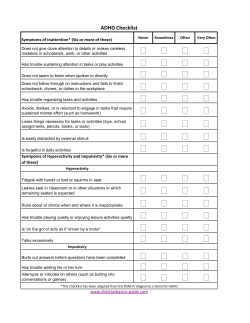
Attention Deficit/Hyperactivity Disorder ADHD) Is it ADHD?
Attention Deficit/Hyperactivity Disorder ADHD) Is it ADHD? Symptom Checklist Deciding if a child has ADHD is a several step process. There is no single test to diagnose ADHD, and many other problems, like anxiety, depression, and certain types of learning disabilities, can have similar symptoms. The American Psychiatric Association's Diagnostic and Statistical Manual, Fifth edition (DSM-5) is used by mental health professionals to help diagnose ADHD. It was released in May 2013 and replaces the previous version, the text revision of the fourth edition (DSM-IV-TR). This diagnostic standard helps ensure that people are appropriately diagnosed and treated for ADHD. Using the same standard across communities will help determine how many children have ADHD, and how public health is impacted by this condition. There were some changes in the DSM-5 for the diagnosis of ADHD: symptoms can now occur by age 12 rather than by age 6; several symptoms now need to be present in more than one setting rather than just some impairment in more than one setting; new descriptions were added to show what symptoms might look like at older ages; and for adults and adolescents age 17 or older, only 5 symptoms are needed instead of the 6 needed for younger children. The criteria are presented in shortened form. Please note that they are provided just for your information. Only trained health care providers can diagnose or treat ADHD. If a parent or other adult is concerned about a child’s behavior, it is important to discuss these concerns with the child’s health care provider. National Center on Birth Defects and Developmental Disabilities Division of Human Development and Disability Simply fill out the child's name, age and today's date and then check off the signs or symptoms the child has shown. Take the completed checklist to your child's health care provider. Child’s name:____________________________________ Child’s age:________ Today’s date:____________ Inattention Six or more of the following symptoms of inattention have been present for at least 6 months to a point that is inappropriate for developmental level Often does not give close attention to details or makes careless mistakes in schoolwork, work, or other activities. Often has trouble keeping attention on tasks or play activities. Often does not seem to listen when spoken to directly. Often does not follow through on instructions and fails to finish schoolwork, chores, or duties in the workplace (loses focus, gets sidetracked). Often has trouble organizing activities. Often avoids, dislikes, or doesn't want to do things that take a lot of mental effort for a long period of time (such as schoolwork or homework). Often loses things needed for tasks and activities (e.g. toys, school assignments, pencils, books, or tools). Is often easily distracted. Is often forgetful in daily activities. Hyperactivity / Impulsivity Six or more of the following symptoms of hyperactivity-impulsivity have been present for at least 6 months to an extent that is disruptive and inappropriate for developmental level Often fidgets with hands or feet or squirms in seat when sitting still is expected. Often gets up from seat when remaining in seat is expected. Often excessively runs about or climbs when and where it is not appropriate (adolescents or adults may feel very restless). Often has trouble playing or doing leisure activities quietly. Is often "on the go" or often acts as if "driven by a motor". Often talks excessively. Often blurts out answers before questions have been finished. Often has trouble waiting one's turn. Often interrupts or intrudes on others (e.g., butts into conversations or games). What do you see? Ask a relative, friend, coach, teacher or child care provider to tell you what your child does. Print a blank checklist and forward them. More information: http://www.cdc.gov/adhd 800-CDC-INFO, TTY: 888-232-6348; cdcinfo@cdc.gov
© Copyright 2025





















